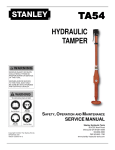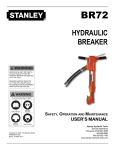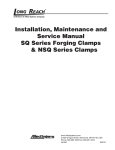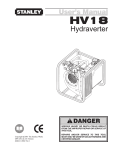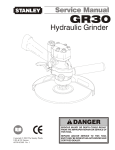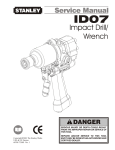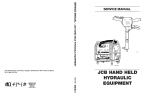Download HYDRAULIC DIGGER
Transcript
DR19 HYDRAULIC DIGGER WARNING To avoid serious injury or death Read the M anual Wear Eye Protection SAFETY, OPERATION AND MAINTENANCE SERVICE MANUAL Wear Ear Protection Wear Dust M ask 4 73 51 Copyright © 2003, The Stanley Works SVCE/MAINT USA 05432 11/2003 Ver 1 Stanley Hydraulic Tools 3810 SE Naef Road Milwaukie OR 97267-5698 503-659-5660 FAX 503-652-1780 www.stanley-hydraulic-tools.com TABLE OF CONTENTS Safety Symbols and Precautions ..................................................................... 4-5 Tool Stickers and Tags ........................................................................................ 6 Hydraulic Hose Requirements ........................................................................... 7 HTMA Requirements ........................................................................................... 8 Operation ............................................................................................................. 9 Equipment Protection and Care ......................................................................... 11 Troubleshooting ................................................................................................ 12 Specifications .................................................................................................... 13 Service ............................................................................................................... 14 Parts Illustration ................................................................................................. 16 Parts List ............................................................................................................ 17 Warranty ............................................................................................................. 18 SERVICING THE STANLEY HYDRAULIC DIGGER: This manual contains safety, operation, and routine maintenance instructions. Stanley Hydraulic Tools recommends that servicing of hydraulic tools, other than routine maintenance, must be performed by an authorized and certified dealer. Please read the following warning. SERIOUS INJURY OR DEATH COULD RESULT FROM THE IMPROPER REPAIR OR SERVICE OF THIS TOOL. REPAIRS AND / OR SERVICE TO THIS TOOL MUST ONLY BE DONE BY AN AUTHORIZED AND CERTIFIED DEALER. For the nearest authorized and certified dealer, call Stanley Hydraulic Tools at the number listed on the back of this manual and ask for a Customer Service Representative. 3 SAFETY SYMBOLS Safety symbols and signal words, as shown below, are used to emphasize all operator, maintenance and repair actions which, if not strictly followed, could result in a life-threatening situation, bodily injury or damage to equipment. This is the safety alert symbol. It is used to alert you to potential personal injury hazards. Obey all safety messages that follow this symbol to avoid possible injury or death. This safety alert and signal word indicate an imminently hazardous situation which, if not avoided, will result in death or serious injury. This safety alert and signal word indicate a potentially hazardous situation which, if not avoided, could result in death or serious injury. This safety alert and signal word indicate a potentially hazardous situation which, if not avoided, may result in minor or moderate injury. This signal word indicates a potentially hazardous situation which, if not avoided, may result in property damage. This signal word indicates a situation which, if not avoided, will result in damage to the equipment. IMPORTANT This signal word indicates a situation which, if not avoided, may result in damage to the equipment. Always observe safety symbols. They are included for your safety and for the protection of the tool. LOCAL SAFETY REGULATIONS Enter any local safety regulations here. Keep these instructions in an area accessible to the operator and maintenance personnel. 4 SAFETY PRECAUTIONS Tool operators and maintenance personnel must always comply with the safety precautions given in this manual and on the stickers and tags attached to the tool and hose. To avoid serious injury or death These safety precautions are given for your safety. Review them carefully before operating the tool and before performing general maintenance or repairs. Read the M anual Supervising personnel should develop additional precautions relating to the specific work area and local safety regulations. If so, place the added precautions in the space provided on page 4. Wear Eye Protection The DR19 Hydraulic Digger will provide safe and dependable service if operated in accordance with the instructions given in this manual. Read and understand this manual and any stickers and tags attached to the tool and hoses before operation. Failure to do so could result in personal injury or equipment damage. Wear Ear Protection Wear Dust M ask 4 73 51 • Operator must start in a work area without bystanders. The operator must be familiar with all prohibited work areas such as excessive slopes and dangerous terrain conditions. • Establish a training program for all operators to ensure safe operation. • Do not operate the tool unless thoroughly trained or under the supervision of an instructor. • Always wear safety equipment such as goggles, ear, head protection, and safety shoes at all times when operating the tool. • Do not inspect or clean the tool while the hydraulic power source is connected. Accidental engagement of the tool can cause serious injury. • Supply hoses must have a minimum working pressure rating of 2500 psi/172 bar. • Be sure all hose connections are tight. • The hydraulic circuit control valve must be in the "OFF" position when coupling or uncoupling the tool. Wipe all couplers clean before connecting. Use only lint-free cloths. Failure to do so may result in damage to the quick couplers and cause overheating of the hydraulic system. • Do not operate the tool at oil temperatures above 140°F/60°C. Operation at higher oil temperatures can cause operator discomfort and may damage the tool. • Do not operate a damaged, improperly adjusted, or incompletely assembled tool. • Do not weld, cut with an acetylene torch, or hardface the tool bit. • To avoid personal injury or equipment damage, all tool repair, maintenance and service must only be performed by authorized and properly trained personnel. • Do not exceed the rated limits of the tool or use the tool for applications beyond its design capacity. • Always keep critical tool markings, such as lables and warning stickers legible. • Always replace parts with replacement parts recommended by Stanley Hydraulic Tools. • Check fastener tightness often and before each use daily. • Never operate the tool if you cannot be sure that underground utilities are not present. • Do not wear loose fitting clothing when operating the tool. 5 TOOL STICKERS & TAGS Stanley Hydraulic Tools 3810 SE Naef Road Milwaukie, OR 97267 FLOW: 7-9 GPM/26-34 LPM PRESSURE: 1500-2000 PSI 105-140 BAR 28853 Name Tag Sticker D A N G E R D A N G E R 1. FAILURE TO USE HYDRAULIC HOSE LABELED AND CERTIFIED AS NON-CONDUCTIVE WHEN USING HYDRAULIC TOOLS ON OR NEAR ELECTRICAL LINES MAY RESULT IN DEATH OR SERIOUS INJURY. BEFORE USING HOSE LABELED AND CERTIFIED AS NON-CONDUCTIVE ON OR NEAR ELECTRIC LINES BE SURE THE HOSE IS MAINTAINED AS NON-CONDUCTIVE. THE HOSE SHOULD BE REGULARLY TESTED FOR ELECTRIC CURRENT LEAKAGE IN ACCORDANCE WITH YOUR SAFETY DEPARTMENT INSTRUCTIONS. 2. A HYDRAULIC LEAK OR BURST MAY CAUSE OIL INJECTION INTO THE BODY OR CAUSE OTHER SEVERE PERSONAL INJURY. The safety tag (p/n 15875) at right is attached to the tool when shipped from the factory. Read and understand the safety instructions listed on this tag before removal. We suggest you retain this tag and attach it to the tool when not in use. A DO NOT EXCEED SPECIFIED FLOW AND PRESSURE FOR THIS TOOL. EXCESS FLOW OR PRESSURE MAY CAUSE A LEAK OR BURST. B DO NOT EXCEED RATED WORKING PRESSURE OF HYDRAU LIC HOSE USED WITH THIS TOOL. EXCESS PRESSURE MAY CAUSE A LEAK OR BURST. C CHECK TOOL HOSE COUPLERS AND CONNECTORS DAILY FOR LEAKS. DO NOT FEEL FOR LEAKS WITH YOUR HANDS. CONTACT WITH A LEAK MAY RESULT IN SEVERE PERSONAL INJURY. D DO NOT LIFT OR CARRY TOOL BY THE HOSES. DO NOT ABUSE HOSE. DO NOT USE KINKED, TORN OR DAMAGED HOSE. 3. MAKE SURE HYDRAULIC HOSES ARE PROPERLY CONNECTED TO THE TOOL BEFORE PRESSURING SYSTEM. SYSTEM PRESSURE HOSE MUST ALWAYS BE CONNECTED TO TOOL "IN" PORT. SYSTEM RETURN HOSE MUST ALWAYS BE CONNECTED TO TOOL "OUT" PORT. REVERSING CONNECTIONS MAY CAUSE REVERSE TOOL OPERATION WHICH CAN RESULT IN SEVERE PERSONAL INJURY. 4. DO NOT CONNECT OPEN-CENTER TOOLS TO CLOSED-CENTER HYDRAULIC SYSTEMS. THIS MAY RESULT IN LOSS OF OTHER HYDRAULIC FUNCTIONS POWERED BY THE SAME SYSTEM AND/ OR SEVERE PERSONAL INJURY. 5. BYSTANDERS MAY BE INJURED IN YOUR WORK AREA. KEEP BYSTANDERS CLEAR OF YOUR WORK AREA. 6. WEAR HEARING, EYE, FOOT, HAND AND HEAD PROTECTION. 7. TO AVOID PERSONAL INJURY OR EQUIPMENT DAMAGE, ALL TOOL REPAIR MAINTENANCE AND SERVICE MUST ONLY BE PERFORMED BY AUTHORIZED AND PROPERLY TRAINED PERSONNEL. I M P O R TA N T I M P O R TA N T READ OPERATION MANUAL AND SAFETY INSTRUCTIONS FOR THIS TOOL BEFORE USING IT. READ OPERATION MANUAL AND SAFETY INSTRUCTIONS FOR THIS TOOL BEFORE USING IT. USE ONLY PARTS AND REPAIR PROCEDURES APPROVED BY STANLEY AND DESCRIBED IN THE OPERATION MANUAL. USE ONLY PARTS AND REPAIR PROCEDURES APPROVED BY STANLEY AND DESCRIBED IN THE OPERATION MANUAL. TAG TO BE REMOVED ONLY BY TOOL OPERATOR. TAG TO BE REMOVED ONLY BY TOOL OPERATOR. SEE OTHER SIDE SEE OTHER SIDE SAFETY TAG P/N 15875 6 (shown smaller then actual size) HYDRAULIC HOSE REQUIREMENTS HOSE TYPES Hydraulic hose types authorized for use with Stanley Hydraulic Tools are as follows: ➊ Certified non-conductive ➋ Wire-braided (conductive) ➌ Fabric-braided (not certified or labeled non-conductive) Hose ➊ listed above is the only hose authorized for use near electrical conductors. Hoses ➋ and ➌ listed above are conductive and must never be used near electrical conductors. HOSE SAFETY TAGS To help ensure your safety, the following DANGER tags are attached to all hose purchased from Stanley Hydraulic Tools. DO NOT REMOVE THESE TAGS. If the information on a tag is illegible because of wear or damage, replace the tag immediately. A new tag may be obtained from your Stanley Distributor. D A N G E R D A N G E R 1 FAILURE TO USE HYDRAULIC HOSE LABELED AND CERTIFIED AS NON-CONDUCTIVE WHEN USING HYDRAULIC TOOLS ON OR NEAR ELECTRIC LINES MAYRESULT IN DEATH OR SERIOUS INJURY. FOR PROPER AND SAFE OPERATION MAKE SURE THAT YOU HAVE BEEN PROPERLY TRAINED IN CORRECT PROCEDURES REQUIRED FOR WORK ON OR AROUND ELECTRIC LINES. 3. DO NOT EXCEED HOSE WORKING PRESSURE OR ABUSE HOSE. IMPROPER USE OR HANDLING OF HOSE COULD RESULT IN BURST OR OTHER HOSE FAILURE. KEEP HOSE AS FAR AWAY AS POSSIBLE FROM BODY AND DO NOT PERMIT DIRECT CONTACT DURING USE. CONTACT AT THE BURST CAN CAUSE BODILY INJECTION AND SEVERE PERSONAL INJURY. 4. HANDLE AND ROUTE HOSE CAREFULLY TO AVOID KINKING, ABRASION, CUTTING, OR CONTACT WITH HIGH TEMPERATURE SURFACES. DO NOT USE IF KINKED. DO NOT USE HOSE TO PULL OR LIFT TOOLS, POWER UNITS, ETC. 2. BEFORE USING HYDRAULIC HOSE LABELED AND CERTIFIED AS NON-CONDUCTIVE ON OR NEAR ELECTRIC LINES. WIPE THE ENTIRE LENGTH OF THE HOSE AND FITTING WITH A CLEAN DRY ABSORBENT CLOTH TO REMOVE DIRT AND MOSISTURE AND TEST HOSE FOR MAXIMUM ALLOWABLE CURRENT LEAKAGE IN ACCORDANCE WITH SAFETY DEPARTMENT INSTRUCTIONS. 5. CHECK ENTIRE HOSE FOR CUTS CRACKS LEAKS ABRASIONS, BULGES, OR DAMAGE TO COUPLINGS IF ANY OF THESE CONDITIONS EXIST, REPLACE THE HOSE IMMEDIATELY. NEVER USE TAPE OR ANY DEVICE TO ATTEMPT TO MEND THE HOSE. 6. AFTER EACH USE STORE IN A CLEAN DRY AREA. SEE OTHER SIDE SEE OTHER SIDE SIDE 1 3 D O N O T R E M O V E T H I S TA G D O N O T R E M O V E T H I S TA G THE TAG SHOWN BELOW IS ATTACHED TO "CERTIFIED NON-CONDUCTIVE" HOSE SIDE 2 (shown smaller than actual size) D A N G E R D A N G E R 1 DO NOT USE THIS HYDRAULIC HOSE ON OR NEAR ELECTRIC LINES. THIS HOSE IS NOT LABELED OR CERTIFIED AS NON-CONDUCTIVE. USING THIS HOSE ON OR NEAR ELECTRICAL LINES MAY RESULT IN DEATH OR SERIOUS INJURY. 5. CHECK ENTIRE HOSE FOR CUTS CRACKS LEAKS ABRASIONS, BULGES, OR DAMAGE TO COUPLINGS IF ANY OF THESE CONDITIONS EXIST, REPLACE THE HOSE IMMEDIATELY. NEVER USE TAPE OR ANY DEVICE TO ATTEMPT TO MEND THE HOSE. 2. FOR PROPER AND SAFE OPERATION MAKE SURE THAT YOU HAVE BEEN PROPERLY TRAINED IN CORRECT PROCEDURES REQUIRED FOR WORK ON OR AROUND ELECTRIC LINES. 6. AFTER EACH USE STORE IN A CLEAN DRY AREA. 3. DO NOT EXCEED HOSE WORKING PRESSURE OR ABUSE HOSE. IMPROPER USE OR HANDLING OF HOSE COULD RESULT IN BURST OR OTHER HOSE FAILURE. KEEP HOSE AS FAR AWAY AS POSSIBLE FROM BODY AND DO NOT PERMIT DIRECT CONTACT DURING USE. CONTACT AT THE BURST CAN CAUSE BODILY INJECTION AND SEVERE PERSONAL INJURY. 4. HANDLE AND ROUTE HOSE CAREFULLY TO AVOID KINKING, CUTTING, OR CONTACT WITH HIGH TEMPERATURE SURFACES. DO NOT USE IF KINKED. DO NOT USE HOSE TO PULL OR LIFT TOOLS, POWER UNITS, ETC. D O N O T R E M O V E T H I S TA G D O N O T R E M O V E T H I S TA G THE TAG SHOWN BELOW IS ATTACHED TO "CONDUCTIVE" HOSE. SEE OTHER SIDE SEE OTHER SIDE SIDE 1 SIDE 2 (shown smaller than actual size) HOSE PRESSURE RATING The rated working pressure of the hydraulic hose must be equal to or higher than the relief valve setting on the hydraulic system. 7 HTMA REQUIREMENTS Tool Category Hydraulic System Requirements Flow rate Tool Operating Pressure (at the power supply outlet) System relief valve setting (at the power supply outlet) Maximum back pressure (at tool end of the return hose) Measured at a max. fluid viscosity of: (at min. operating temperature) Temperature Sufficient heat rejection capacity to limit max. fluid temperature to: 20Lpm at 138bar BHTMA CATEGORY 30Lpm at 138bar BHTMA CATEGORY Type I Type II 40Lpm at 138bar EHTMA CATEGORY Type III 4-6 gpm 7-9 gpm 10.5-11.6 gpm 11-13 gpm (15-23 lpm) (26-34 lpm) (36-44 lpm) (42-49 lpm) 2000 psi 2000 psi 2000 psi 2000 psi (138 bar) (138 bar) (138 bar) (138 bar) 2100-2250 psi 2100-2250 psi 2100-2250 psi 2100-2250 psi (145-155 bar) (145-155 bar) (145-155 bar) (145-155 bar) 200 psi 200 psi 200 psi 200 psi (14 bar) (14 bar) (14 bar) (14 bar) 400 ssu* 400 ssu* 400 ssu* 400 ssu* (82 centistokes) (82 centistokes) (82 centistokes) (82 centistokes) 140° F (60° C) 140° F (60° C) 140° F (60° C) 140° F (60° C) 3 hp (2.24 kW) 40° F (22° C) 5 hp (3.73 kW) 40° F (22° C) 6 hp (4.47 kW) 40° F (22° C) 7 hp (5.22 kW) 40° F (22° C) 25 microns 18 gpm (68 lpm) 25 microns 25 microns 25 microns 30 gpm (114 lpm) 35 gpm (132 lpm) 40 gpm (151 lpm) 100-400 ssu* 100-400 ssu* 100-400 ssu* 100-400 ssu* (20-82 centistokes) (20-82 centistokes) (20-82 centistokes) (20-82 centistokes) (at max. expected ambient temperature) Min. cooling capacity at a temperature difference of between ambient and fluid temps NOTE: Do not operate the tool at oil temperatures above 140° F (60° C). Operation at higher temperatures can cause operator discomfort at the tool. Filter Min. full-flow filtration Sized for flow of at least: (For cold temp. startup and max. dirt-holding capacity) Hydraulic fluid Petroleum based (premium grade, anti-wear, non-conductive) Viscosity (at min. and max. operating temps) NOTE: When choosing hydraulic fluid, the expected oil temperature extremes that will be experienced in service determine the most suitable temperature viscosity characteristics. Hydraulic fluids with a viscosity index over 140 will meet the requirements over a wide range of operating temperatures. NOTE: These are general hydraulic system requirements. See tool Specification page for tool specific requirements. 8 OPERATION PREOPERATION PROCEDURES CONNECT HOSES PREPARATION FOR INITIAL USE 1. Wipe all hose couplers with a clean lint-free cloth before making connections. The tool, as shipped, has no special unpacking or assembly requirements prior to usage. Inspection to assure the tool was not damaged in shipping and does not contain packing debris is all that is required. 2. Connect the hoses from the hydraulic power source to the hose couplers on the tool. It is a good practice to connect the return hose first and disconnect it last to minimize or avoid trapped pressure within the tool. CHECK HYDRAULIC POWER SOURCE 3. Observe flow indicators stamped on hose couplers to be sure that oil will flow in the proper direction. The female coupler is the inlet coupler. 1. Using a calibrated flowmeter and pressure gauge, check that the hydraulic power source develops a flow of 7-9 gpm/ 26-34 lpm at 1500-2000 psi/105-140 bar. NOTE: The pressure increase in uncoupled hoses left in the sun may result in making them difficult to connect. When possible, connect the free ends of operating hoses together. 2. Make certain the hydraulic power source is equipped with a relief valve set to open at 2100-2250 psi/145-155 bar minimum. 3. Check that the hydraulic circuit matches the tool for open-center (OC) operation. OPERATING PROCEDURES CHECK TOOL 1. Observe all safety precautions. 1. Make sure all tool accessories are correctly installed. Failure to install tool accessories properly can result in damage to the tool or personal injury. 2. Move the hydraulic circuit control valve to the "ON" position. 3. Place the tool bit firmly on the surface you are to work on. 2. There should be no signs of leaks. 4. squeeze the trigger to start the tool. Adequate down pressure is very important. 3. The tool should be clean, with all fittings and fasteners tight. CHECK TRIGGER MECHANISM 1. Check that the trigger operates smoothly and is free to travel between the "ON" and "OFF" positions. NOTICE INSTALL TOOL BIT NOT FOR UNDERWATER USE The tool accepts standard 7/8 x 3-1/4 inch hex shank tool bits. TO INSTALL A HEX SHANK TOOL BIT 1. Push in the retainer, insert the hex shank tool bit and move the retainer back into locked position. Note the orientation of the particular tool bit that is being installed. 9 OPERATION COLD WEATHER OPERATION If the tool is to be used during cold weather, preheat the hydraulic fluid at low engine speed. When using the normally recommended fluids, fluid temperature should be at or above 50° F/10° C (400 ssu/82 centistokes) before use. STORAGE 1. Disconnect the tool from the hydraulic power source. 2. Remove the tool bit and spray the tool bit retainer area with WD-40™ inside and out. 3. Wipe clean and store in a clean, dry place. 10 EQUIPMENT PROTECTION & CARE In addition to the Safety Precautions on page 4 & 5 of this manual, observe the following for equipment protection and care. • Make sure all couplers are wiped clean before connection. • The hydraulic circuit control valve must be in the “OFF” position when coupling or uncoupling hydraulic tools. Failure to do so may result in damage to the quick couples and cause overheating of the hydraulic system. • Always store the tool in a clean dry space, safe from damage or pilferage. • Make sure the circuit PRESSURE hose (with male quick disconnect) is connected to the “IN” port. The circuit RETURN hose (with female quick disconnect) is connected to the opposite port. Do not reverse circuit flow. This can cause damage to internal seals. • Always replace hoses, couplings and other parts with replacement parts recommended by Stanley Hydraulic Tools. Supply hoses must have a minimum working pressure rating of 2500 psi/172 bar. • Do not exceed the rated flow (see Specifications) page 19 in the manual for correct flow rate and model number. Rapid failure of the internal seals may result. • Always keep critical tool markings, such as warning stickers and tags legible. • Do not force a small tool to do the job of a large breaker. • Keep tool bit sharp for maximum tool performance. Make sure that tool bits are not chipped or rounded on the striking end. • Never operate a tool without a tool bit or without holding it against the work surface. This puts excessive strain on the breaker foot. • Tool repair should be performed by experienced personnel only. • Make certain that the recommended relief valves are installed in the pressure side of the system. • Do not use the tool for applications for which it was not intended. 11 TROUBLESHOOTING Tool does not run. Tool does not hit effectively. Tool operates slow. Power unit not functioning. Check power unit for proper flow and pressure (7-9gpm/26-34 lpm, 1500-2000 psi/105-140 bar. Couplers or hoses blocked. Remove restriction. Presssure and return line hoses reversed at ports. Be sure hoses are connected to their proper ports. Mechanical failure of piston or internal parts. Have inspected and repaired by authorized dealer. Power unit not functioning. Check power unit for proper flow and pressure (7-9gpm/26-34 lpm, 1500-2000 psi/105-140 bar. Couplers or hose blocked. Remove restriction, Fluid too hot (above 140° F / 60° C). Provide cooler to maintain proper fluid temperature. Incorrect tool bit Ensure tool bit meets specifica tions Low oil flow from power unit. Check power source for proper flow. High backpressure. Check hydraulic system for excessive backpressure and correct as required. 12 SPECIFICATIONS Weight .......................................................................................................................................................... 24 lbs / 10.9 kg Pressure Range ......................................................................................................................... 1500-2000 psi / 105-140 bar Flow Range ............................................................................................................................................ 7-9 gpm / 26-34 lpm Optimum Flow ................................................................................................................................................ 8 gpm / 30 lpm Porting ............................................................................................................................................. 3/8” male pipe hose end Length ........................................................................................................................................................ 20 inches / 51 cm System Type ...................................................................................................................................................... Open Center Accessory Shank ......................................................................................................................................... 7/8” hex x 3-1/4” 13 SERVICE REMOVE THE SLIDE RETAINER 1. Loosen and remove the two capscrews from the retaining nose assembly. spool with a twisting motion through the bore and seals so as not to cut the new seals. Lubrication is necessary so that the seals can easily pass over the spool groove. 5. Reinstall the retaining ring in its groove. NOTE: The two spring-and-ball detents will push the retainer and retainer cap away as the caspcrews are loosened. The springs will be unloaded before the capscrews are fully out of the threads. 6. Put the trigger in place, then drive the dowel pin through the trigger to slightly below the handle surface on both sides of the handle body assembly. Stake the aluminum handle material around the dowel pin to retain it. 2. The balls will fall free as soon as the retainer cap is lifted away from the retaining nose. DISASSEMBLE THE DIGGER ASSEMBLE THE SLIDE RETAINER 1. With the retainer nose held vertically, install the springs into the spring holes in the retainer nose. 2. Place the balls on the ends of the springs. Position the retainer on the ball-and-spring detents with the detent impressions of the retainer set on the balls. 3. Place the retainer cap on the retainer. Hold these parts in position and install the capscrews and lockwashers. Use a thread locking adhesive such as Loctite™ 242 on the capscrew threads. Tighten the capscrews to 25-30 ft lbs / 34-41 Nm. REMOVE THE ON/OFF VALVE SPOOL To replace the On/Off valve spool seals, the On/Off valve spool must be removed from the handle body assembly. 1. Drive out the dowel pin and remove the trigger. 2. Remove the retaining ring and then the On/Off valve spool can be pulled out of its bore. 3. Remove the two seals from the grooves in the handle body assembly and install the new seals. If quad ring seals are installed, they will seem too big for the groove until all the ring is worked into the groove. Lubricating the quad ring eases the installation. 1. Clamp the pick horizontally in a vise by the retaining nose assembly bolt flange. Remove the four bolt assemblies. 2. While pulling the handle body assembly, assist the removal by driving the assembly with a soft faced mallet. 3. The valve body, oil tube and piston can be removed by putting a 1/2 inch rod through the retaining nose assembly and driving the parts out with a hammer, being careful to ease the parts out, not causing damage. Remove the pin (39). NOTE: Clamping the pick at the flow sleeve assembly will close the internal clearances and make removal of the piston difficult. 4. To remove the retaining nose assembly from the flow sleeve assembly, clamp the flow sleeve assembly in a vise just tight enough to hold the flow sleeve assembly while driving the retaining nose assembly off with a soft faced mallet. Hammer against the bolt flange while pulling and guiding the retaining nose assembly. 5. The valve gland is removed from the valve body by pushing reversing spool against the valve gland through the valve body. REASSEMBLY OF THE DIGGER Inspect all parts for excessive wear. Lubricate all seals before installing them. 4. When replacing the On/Off valve spool, carefully push the 14 SERVICE 1. Clamp the bolt flange of the retaining nose assembly in a vise so that retainer cap end of the assembly faces downward. NOTE: Lubicate with hydraulic fluid all parts used in the following steps. 2. Iinstall the back-up ring followed by the o-ring. Install the wiper ring (lips facing down), the insert, and the rod seal (lips facing up). 3. Install the flow sleeve onto the retaining nose assembly. Tap the flow sleeve onto the retaining nose assembly. 4. Install the piston into the flow sleeve. 5. Install an o-ring onto the oil tube. Install the oil tube into the piston. Push the oil tube down into the counterbore in the flow sleeve. 6. Install the reversing spool into the valve body as shown in the parts illustration. Install two o-rings onto the valve body. Install an o-ring onto the valve gland. Install the valve gland onto the reversing spool stem and push it into the bore of the valve body. 7. Install the pin into the flow sleeve. Align the hole in the valve body with the pin and push the valve body into the flow sleeve tube until it stops against the flow sleeve. 8. Lubricate with grease and install a back-up ring, followed by an o-ring, into the groove in the handle body assembly. 9. Install the handle body assembly onto the flow sleeve tube and secure with the four bolt assemblies. Tighten the bolt assemblies to 20 ft lbs / 28 Nm in a cross pattern. ADDITONAL NOTES 1. Obtain Seal Kit Part Number 03331 prior to disassembly so you can replace all seals exposed. Note the orientation of seals before removing them. Install new seals in the same way. 2. If the digger is to be repainted after servicing, be sure to mask off the exposed end of the valve spool and its spring. Do not allow paint to enter the “in” and “out” ports or the bore of the retaining nose. 15 DR19 PARTS ILLUSTRATION 16 DR19 PARTS LIST ITEM 1 2 3 4 5 6 7 8 9 10 11 12 13 14 15 16 17 18 19 20 21 22 23 24 25 26 27 28 29 30 31 32 33 34 35 36 37 38 39 P/N 02890 02853 24316 02959 24348 02901 03252 01412 02846 02881 03252 00752 03973 03972 28853 03786 02869 03658 01259 03253 02848 02880 00211 03254 01772 02454 02177 02865 03959 02907 04175 03127 03942 03536 03190 02436 03552 03553 02843 QTY 1 1 1 1 1 1 2 2 1 1 2 1 1 1 1 1 1 1 1 1 4 1 2 1 1 4 2 2 1 1 1 1 1 1 2 2 1 2 1 DESCRIPTION SEAL KIT PART NUMBER 03331 Handle Body Assembly Trigger Dowel Pin 3/16 x 1-1/2 Spool Screw Washer O-Ring .239 x .367 x .064 O-Ring 7/16 x 9/16 x 1/16 Hose Assembly Spring On/Off Spool, Open Center O-Ring Retaining Ring 7/16 ext. Male Coupler Body Female Coupler Body Name Tag GPM Sticker Flow Sleeve Assembly Oil Tube O-Ring 1-1/2 x 1-5/8 x 1/16 Valve Body Bolt Assembly Reversing Spool O-Ring 1 x 1-1/8 x 1/16 Valve Gland O-Ring 3/4 x 7/8 x 1/16 Allen Nut (furnished with item 21) O-Ring 2-1/16 x 2-1/4 x 3/32 Back-up Ring Piston Rod Seal 1-1/4 x 1-1/2 x 5/16 x 3/16 Insert Wiper Ring Retaining Nose Assembly Retainer Spring Ball Retainer Cap Capscrew 3/8 x 24 x 2-1/2 Pin 17 02901 03252 02865 02177 03127 02302 01259 01772 00211 02907 O-RING O-RING BACK-UP RING O-RING ROD WIPER ROD SEAL O-RING O-RING O-RING ROD SEAL 1 2 2 2 1 1 1 1 2 1 REPAIR KIT PART NUMBER 03943 00752 02848 02843 03536 03190 02436 03331 RETAINING RING BOLT ASSEMBLY PIN RETAINER SPRING BALL SEAL KIT 1 2 1 1 2 2 1 WARRANTY Stanley Hydraulic Tools (hereinafter called “Stanley”), subject to the exceptions contained below, warrants new hydraulic tools for a period of one year from the date of sale to the first retail purchaser, or for a period of 2 years from the shipping date from Stanley, whichever period expires first, to be free of defects in material and/or workmanship at the time of delivery, and will, at its option, repair or replace any tool or part of a tool, or new part, which is found upon examination by a Stanley authorized service outlet or by Stanley’s factory in Milwaukie, Oregon to be DEFECTIVE IN MATERIAL AND/OR WORKMANSHIP. EXCEPTIONS FROM WARRANTY FREIGHT COSTS: Freight costs to return parts to Stanley, if requested by Stanley for the purpose of evaluating a warranty claim for warranty credit, are covered under this policy if the claimed part or parts are approved for warranty credit. Freight costs for any part or parts which are not approved for warranty credit will be the responsibility of the individual. SEALS & DIAPHRAGMS: Seals and diaphragms installed in new tools are warranted to be free of defects in material and/or workmanship for a period of 6 months after the date of first usage, or for a period of 2 years from the shipping date from Stanley, whichever period expires first. CUTTING ACCESSORIES: Cutting accessories such as breaker tool bits are warranted to be free of defects in material and or workmanship at the time of delivery only. ITEMS PRODUCED BY OTHER MANUFACTURERS: Components which are not manufactured by Stanley and are warranted by their respective manufacturers. a. Costs incurred to remove a Stanley manufactured component in order to service an item manufactured by other manufacturers. ALTERATIONS & MODIFICATIONS: Alterations or modifications to any tool or part. All obligations under this warranty shall be terminated if the new tool or part is altered or modified in any way. NORMAL WEAR: any failure or performance deficiency attributable to normal wear and tear such as tool bushings, retaining pins, wear plates, bumpers, retaining rings and plugs, rubber bushings, recoil springs, etc. INCIDENTAL/CONSEQUENTIAL DAMAGES: To the fullest extent permitted by applicable law, in no event will STANLEY be liable for any incidental, consequential or special damages and/or expenses. FREIGHT DAMAGE: Damage caused by improper storage or freight handling. LOSS TIME: Loss of operating time to the user while the tool(s) is out of service. IMPROPER OPERATION: Any failure or performance deficiency attributable to a failure to follow the guidelines and/or procedures as outlined in the tool’s operation and maintenance manual. MAINTENANCE: Any failure or performance deficiency attributable to not maintaining the tool(s) in good operating condition as outlined in the Operation and Maintenance Manual. HYDRAULIC PRESSURE & FLOW: Any failure or performance deficiency attributable to excess hydraulic pressure, excess hydraulic back-pressure, or excess hydraulic flow. REPAIRS OR ALTERATIONS: Any failure or performance deficiency attributable to repairs by anyone which in Stanley’s sole judgement caused or contributed to the failure or deficiency. MIS-APPLICATION: Any failure or performance deficiency attributable to mis-application. “Mis-application” is defined as usage of products for which they were not originally intended or usage of products in such a matter which exposes them to abuse or accident, without first obtaining the written consent of Stanley. WARRANTY REGISTRATION: STANLEY ASSUMES NO LIABILITY FOR WARRANTY CLAIMS SUBMITTED FOR WHICH NO TOOL REGISTRATION IS ON RECORD. In the event a warranty claim is submitted and no tool registration is on record, no warranty credit will be issued without first receiving documentation which proves the sale of the tool or the tools’ first date of usage. The term “DOCUMENTATION” as used in this paragraph is defined as a bill of sale, or letter of intent from the first retail customer. A WARRANTY REGISTRATION FORM THAT IS NOT ALSO ON RECORD WITH STANLEY WILL NOT BE ACCEPTED AS “DOCUMENTATION”. NO ADDITIONAL WARRANTIES OR REPRESENTATIONS This limited warranty and the obligation of Stanley thereunder is in lieu of all other warranties, expressed or implied including merchantability or fitness for a particular purpose except for that provided herein. There is no other warranty. This warranty gives the purchaser specific legal rights and other rights may be available which might vary depending upon applicable law. 18 Stanley Hydraulic Tools 3810 SE Naef Road Milwaukie OR 97267-5698 503-659-5660 FAX 503-652-1780 www.stanley-hydraulic-tools.com




















